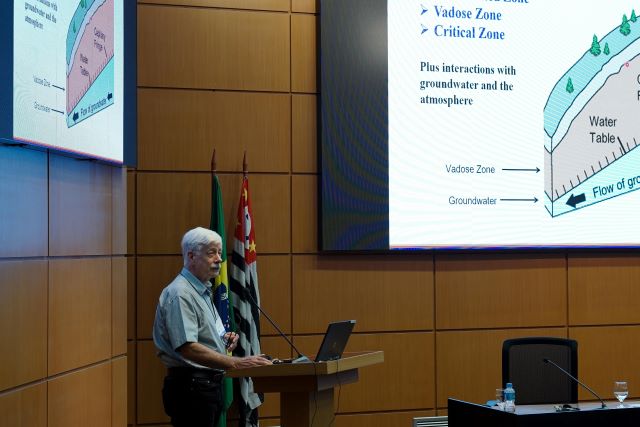

Van Genuchten is a leading expert on the vadose zone, the unsaturated part of the subsurface above the water table (photo: Daniel Antonio/Agência FAPESP)
Dutch-born scientist Martinus Theodorus van Genuchten is the author of a famous equation describing the hydraulic conductivity of unsaturated soil. His discoveries are central to agricultural operations and climate science, and he recently won the prestigious Wolf Prize in Agriculture.
Dutch-born scientist Martinus Theodorus van Genuchten is the author of a famous equation describing the hydraulic conductivity of unsaturated soil. His discoveries are central to agricultural operations and climate science, and he recently won the prestigious Wolf Prize in Agriculture.

Van Genuchten is a leading expert on the vadose zone, the unsaturated part of the subsurface above the water table (photo: Daniel Antonio/Agência FAPESP)
By José Tadeu Arantes | Agência FAPESP – The bottom layer of Earth’s atmosphere, the troposphere, extends up to about 10 kilometers above the surface of our planet. The top layer of the soil is about a meter deep or less, but it is indispensable to human life and should be treated with great care. This idea was presented by physicist Oswaldo Baffa Filho in his opening remarks to the audience for the Fifth FAPESP Lecture 2023, which focused on “The world of porous media in agriculture and the environment”.
The lecture was delivered at FAPESP’s auditorium by Dutch physicist Martinus Theodorus (“Rien”) van Genuchten, winner of the 2023 Wolf Prize in Agriculture, one of the world’s most prestigious awards, and possibly the world’s foremost living expert on porous media.
It is always a privilege to attend a lecture by someone after whom an important scientific equation is named. Van Genuchten’s equation (1980) describes and predicts the hydraulic conductivity of unsaturated soil. With Czech-born US Professor Jirka Simunek, van Genuchten later developed Hydrus, a software suite used to simulate the movement of water, heat and solutes in variably saturated porous media.
Van Genuchten was born in 1945 in Vught, Netherlands. He grew up on a small farm and was one of few people with his social background to obtain a university education at the time. He graduated from Wageningen University in the Netherlands and earned a PhD from New Mexico State University in the United States. He spent most of his career at the US Salinity Laboratory, an arm of the Department of Agriculture (USDA) located in Riverside, California. Currently, besides lecturing and giving courses around the world, he divides his time between the Federal University of Rio de Janeiro (UFRJ) in Brazil and Utrecht University in the Netherlands.
As he remarked during the lecture, while he was conducting research for his PhD in the US, he had to answer four questions that to some extent are challenges that inform the entire scientific process. How to do experiments? What theoretical model to use? How to get a mathematical solution (analytical or numerical)? How to fit the solution to the experimental data?
“My focus has always been what I call the near-surface environment – the vadose zone, from the Latin vadosus, meaning shallow. It’s the unsaturated part of the subsurface above the water table,” he said.
Vadose soil and rocks contain air and water in their pores. Understanding how this air and water flows is fundamental to the success of agriculture, and to preventing transportation of contaminants, preserving the quality of the water available for human consumption, and controlling floods.
In a career lasting almost half a century, van Genuchten transformed the fields of soil physics and vadose zone hydrology, which are central to modern agricultural operations and climate science. His porosity and dual permeability models are especially important, as he showed in the lecture, enabling him to adjust analytical predictions to experimental data with greater precision. The existence of an analytical solution to phenomena as complex as subsurface flows and transport in a highly heterogeneous medium may actually come as a surprise to non-specialists. Someone in the audience at the lecture asked about big data, machine learning and other computational techniques to simulate these, considering the plethora of variables involved, but van Genuchten’s contributions will evidently be crucial to these developments.
The professor raised an interesting point concerning pitcher irrigation as used by small family farmers. The pitchers are round porous clay pots buried in the soil near the crop and filled with water, which seeps out slowly through the porous walls of the pots and reaches the roots. As the plants consume water, more water seeps out of the pots. Van Genuchten showed photographs of this ancient traditional process being used in Sindh, a province of Pakistan, and referred the audience to an article by himself and collaborators, published in Soil Science in 2009.
Contrasting this parsimonious method with the sprinkler, furrow and basin irrigation systems used currently in large-scale agriculture, van Genuchten wondered whether the latter are sustainable.
The Fifth 2023 FAPESP Lecture was introduced by Professor Marco Antonio Zago, President of FAPESP, who noted that van Genuchten has worked in several countries including Brazil. The event was moderated by Silvio Crestana, CEO of the Brazilian Agricultural Research Corporation (EMBRAPA) between 2005 and 2009, who recalled that van Genuchten’s equation, which applies to both water and contaminant flows, is the most prominent in the relevant scientific literature.
To watch a recording of the event, visit: www.youtube.com/watch?v=eRNW8fBxp9Y.
Republish
The Agency FAPESP licenses news via Creative Commons (CC-BY-NC-ND) so that they can be republished free of charge and in a simple way by other digital or printed vehicles. Agência FAPESP must be credited as the source of the content being republished and the name of the reporter (if any) must be attributed. Using the HMTL button below allows compliance with these rules, detailed in Digital Republishing Policy FAPESP.





